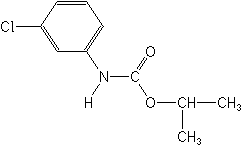-
Physical Properties
Molecular weight:213.7; Physical form:Colourless solid. Density:1.180 (30 °C); Composition:Tech. grade is 98.5% pure. Melting point:41.4 °C (pure); 38.5-40 °C (tech.); Solubility:In water 89 mg/l (25 °C). Readily soluble in most organic solvents, e.g. alcohols, ketones, esters, chlorinated hydrocarbons, aromatic hydrocarbons, etc. Moderately soluble in mineral oils (e.g. 100 g/kg in kerosene).; Stability:Stable to u.v. light. Decomposes above 150 °C. Hydrolysed slowly in acidic and alkaline media. Soluble in ethyl and isopropyl alcohols, ketones, aromatic solvents.
-
Toxicology
Oral:Acute oral LD50 for rats 3800 mg/kg, rabbits 5000 mg/kg.
-
Environmental Profile
Ecotoxicology:
Bees:Not hazardous to bees when used as recommended.Birds:Acute oral LD50 for mallard ducks >2000 mg/kg.Fish:LC50 (48 h) for bluegill sunfish 12 mg/l, bass 10 mg/l,rainbow trout 3.02-5.7 ppm; bluegill 6.3-6.8 ppm. Bird: LD50 >2000 mg/kg (mallard). Environmental fate:
Animals:In mammals, following oral administration, the principal metabolic route is by hydroxylation at the para position and conjugation of the resultant 4-hydroxychloropropham with sulfate. There is also some hydroxylation of the isopropyl residue.Soil:In soil, microbial degradation leads to the production of 3-chloroaniline by an enzymic hydrolysis reaction, with liberation of CO2. DT50 in soil c. 65 d (15 °C), 30 d (29 °C).Plant:In soya beans, three major metabolites have been identified, isopropyl N-4-hydroxy-3-chlorophenylcarbamate, isopropyl N-5-chloro-2-hydroxyphenylcarbamate, and 1-hydroxy-2-propyl-3'-chlorocarbanilate, whilst, in cucumbers, only the first
WATER SOLUBILITY: 89 mg/l at 25° C
-
Transport Information
Signal Word:DANGER; Hazard Class:Ib (Highly hazardous)

 0
0 Subscribe
Subscribe
